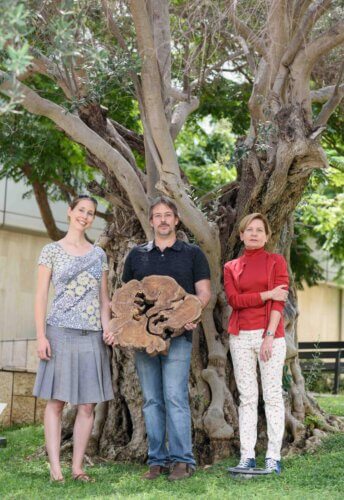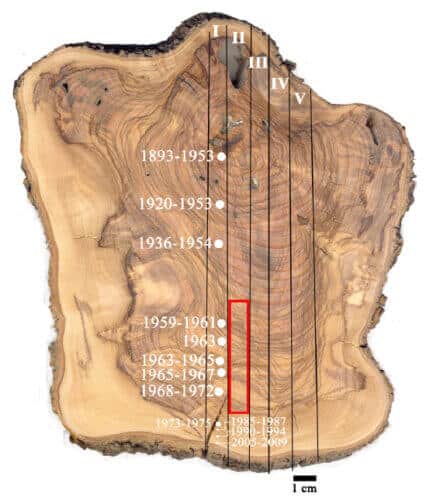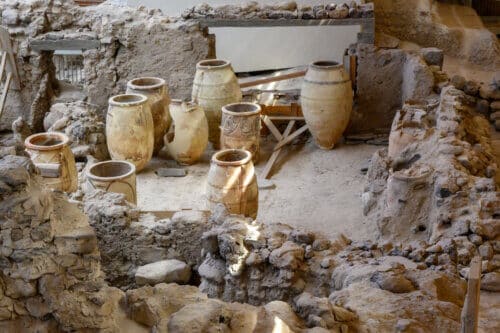Weizmann Institute of Science scientists settle a dispute surrounding the eruption of the Santorini volcano with the help of an olive tree from the Galilee and radiation residues from nuclear tests They concluded that the mountain erupted between 1630 and 1620 BC - and not between 1550 and 1500 BC as stated in previous studies.

When the Santorini volcano, now in the territory of Greece, erupted with tremendous force about 3,500 years ago, huge amounts of lava, rocks and ash were scattered everywhere. An olive tree branch discovered in volcanic ash in Santorini about two decades ago ignited a sharp debate among archaeologists about the date of occurrence of that dramatic eruption that may have led to the extinction of the Minoan culture on the nearby island of Crete. While archaeologists tend to place the eruption in the second half of the 16th century BC, a group of scientists who studied the sooty branch using carbon-14 dating claimed that the event occurred nearly 100 years earlier. Now, with the help of an olive tree branch from the Galilee and radiation residues from nuclear experiments conducted in the 50s and 60s, the scientists of the Weizmann Institute of Science were able to reconcile the conflicting findings.
The annual growth cycle of the olive tree is not such a simple matter. Although a cross-section of an olive tree will reveal apparently ordered growth rings, unlike other tree species, these rings do not necessarily represent annual growth cycles. To circumvent this complexity, the research group that extended the branch from Santorini used CT scans to detect subtle differences in the density levels of the branch's layers. Based on the assumption that the differences in compressibility found represent annual growth cycles, the researchers extended the age of the outermost ring and determined that the eruption of the volcano occurred between 1630 and 1620 BC - and not between 1500 and 1550 BC as determined in previous studies.

The olive tree symbolizes peace and brotherhood in different cultures, but the branch from Santorini actually led to a scientific conflict. Prof. Elisabetta Boerto From the Department of Scientific Archeology at the Weizmann Institute of Science and her group members, Dr. Yael Ehrlich and Dr. Lior Regev, decided to get to the root of the matter and try to make peace. As part of Dr. Ehrlich's doctoral thesis, the members of the research group brought to their laboratory a branch of an olive tree about 70 years old from the Galilee, and tried to date its growth rings using micro CT and high-resolution carbon-14 dating, with the help of the Dangor particle accelerator in her laboratory of Prof. Boarto. To arrive at a particularly precise date, down to the level of a single month, the researchers used the seal left by nuclear tests conducted in the 50s and 60s as part of the nuclear arms race after World War II; These experiments led in those years to the doubling of the concentration of carbon-14 in the atmosphere.
With the help of this "nuclear seal" the researchers were able to map the growth cycles of the olive tree with a very high level of accuracy and distinguish which months of the year the tree grew new parts. This is how the researchers discovered, among other things, that when olive trees "age" they may continue to grow certain parts and stop growing others. While these differences between the "living" and "dead" parts are invisible to the eye - a laboratory test revealed dating differences of 40 years between two samples from the outer perimeter of the tree. These findings offer a new interpretation for the differences in the dating of the Santorini eruption: the scientific dating may indeed have been accurate, but the charred branch belonged to a part of the tree that stopped growing many decades before the eruption. When the researchers took into account this scenario and other possible scenarios that emerged from their findings, they concluded that the scientific dating of the branch from Santorini may coincide with the dating based on other archaeological findings.

"This is certainly not the last word when it comes to the dating of the eruption of the volcano in Santorini," says Prof. Boarto, "however, we were able to demonstrate in the research how it is possible to discard samples of a young tree on the dating of archaeological remains. Now that we have defined the biological clock of the olive tree, it will be possible to more accurately date the growth rings of ancient olive trees that are so common in our region."
